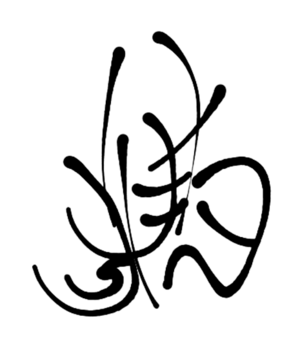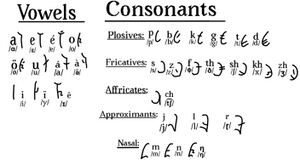Moshurian
This article is a construction site. This project is currently undergoing significant construction and/or revamp. By all means, take a look around, thank you. |
| Moshurian | |
|---|---|
| uthilikh | |
 The Moshurian endonym(uthilikh) written in Moshurian script. | |
| Pronunciation | [ˈuð.ilix] |
| Created by | Jukethatbox |
| Setting | Radael |
| Native to | Moshurian Empire |
| Native speakers | ~450,000,000 (400 UH) |
Yeldhic
| |
Early forms | Kóftąbriác Yeldha
|
Standard form | Taráhus Moshurian
|
Dialects |
|
| |
| Official status | |
Official language in | Moshurian Empire Iśatúr Confederacy |
Recognised minority language in | Eastern Gegfen Alliance |
| Regulated by | Ministry of Linguistic Regulation |
 Map of Moshurian speakers. Dark green represents a Moshurian-speaking majority and light green represents a significant minority. | |
Moshurian(uthilikh) is a Týbric language spoken in mostly Talkoch. It is the most spoken language in Talkoch, and also has significant minority communities on Etzeán Island and the Eastern Gegfen Alliance, also called the Dmuriékh(lit. "far away east"). It is the sole official language of the Moshurian Empire, and is thoroughly used administratively and academically in the Moshurian Empire, no matter what one's mother tongue is.
Their exonym of Moshurian comes from a nomadic legend of the god of travel and nomads, Dündŵęk, who traveled to Tuloor Lake(the homeland of the Moshurians) in search of an inn to rest. The Moshurians had plenty of inns(möşhüř as they are called in Ancient Yeldha), and Dündŵęk was finally able to rest. After departing, he thanked the Moshurians, and later mentioned them to the other gods as simply möşhüřiànöřmà, or "inn people". This exonym stuck within nomadic circles, who then passed the exonym to the more settled peoples of Talkoch.
It is one of the only surviving languages indigenous to the Munsanukh Valley, which is generally considered, alongside Tuloor Lake, to be the birthplace of the Moshurian race, culture and language.
Phonology
Orthography
Moshurian has its own script that is read right-to-left, top-to-bottom. Each symbol can be easily deciphered by simply looking at how high or low the symbol is. If the symbol goes down below the line on the paper, it is a consonant.
The origin of the Moshurian alphabet is heavily debated. According to the Gécheb Bizörith, the Moshurian alphabet was designed by a secret society called Akhakuöm, who took inspiration from the Tiragii military cuneiform. Eventually after the bust of Akhakuöm by the Moshurian state, the script was changed to fit the standard Moshurian dialect and re-issued as the government Moshurian alphabet.
In the Sóvók religion, one of the books in the Idērigidwi claims that a man named Udeldoi presented a script to the king of Moshuria so as to record military victories for propaganda.
Both of these interpretations are considered simply as urban legend, as orthographic analysis of the Izkanà(one of the earliest Moshurian documents) by calligraphers showed that the early Moshurian alphabet had many similarities with the logographic Oalanii[1] script, which may have influenced Munsanukh orthographies as a whole.
In fact, the glyph for /b/ may be descended from the Oalanii glyph for the word *ʔbVn, meaning "tree", which influenced its shape.
Consonants
| Labial | Dental | Alveolar | Post- alveolar/ palatal |
Retroflex | Velar | Glottal | ||||||||
|---|---|---|---|---|---|---|---|---|---|---|---|---|---|---|
| Nasal | m | n | ŋ | |||||||||||
| Stop | p | b | t | d | k | ɡ | ||||||||
| Affricate | t͡ʃ | |||||||||||||
| Fricative | ɸ | ð | s | z | ʃ | ʒ | x | h | ||||||
| Approximant | j | |||||||||||||
| Lateral | l | |||||||||||||
| Flap | ɽ | |||||||||||||
Vowels
| Front | Near-front | Central | Back | ||
|---|---|---|---|---|---|
| Close | i | y | u | ||
| Near-close | ɪ | ||||
| Close-mid | e | ø | o | ||
| Mid | ə(ə̃) | ||||
| Open-mid | ε | ||||
| Open | a | ɑ | |||
Prosody
Stress
Stress in Moshurian is paroxytonic, meaning stress is placed on the penultimate syllable of a word, e.g. zazuŋ, pronounced [ˈzaˌzuŋ], or uthilikh, pronounced [ˈuð.ilix].
Phonotactics
Syllables in Moshurian typically follow the pattern of (C)V(C), or (consonant)-vowel-(consonant).
Morphology
See also: Moshurian/Swadesh list.
Tenses
In Moshurian, there are four main tenses- the present, the future, the far future and the simple past. To indicate that a phrase is in a certain tense, an indicator is used just before the object, e.g. öş gersetigéd kestolék(I built a house).
| Present | Future | Far Future | Simple Past |
|---|---|---|---|
| (uź) | ïş | ïşé | öş |
The present tense indicator, uź, is used like a natural in music. By default, no indicator is used to indicate the present in a non-contextual sentence, but as indicators are continuous, meaning that if an indicator is placed then all succeeding sentences will be in the indicator's tense until a new indicator appears, uź may be needed to clarify that a sentence does not follow the tense of the previous sentence.
Example: öş abáragéd udubék. budur ibiş. - I went to the park. It was[2] great.
ös abáragéd udubék. uź budur ibiş. - I went to the park. (The park) is great.
Nouns
Nouns in Moshurian have two forms: the infinitive and the accusative. The infinitive, like with verbs, is essentially the raw form of the noun, with no suffixes. The accusative is the infinitive + the suffix -géd, and is used when a verb is acting upon an object in a sentence. There are some exceptions, such as nouns who's infinitive end with /ŋ/, such as zazuŋ, and in this case the suffix changes from -géd to -éd.
Verbs
Verbs in Moshurian are inflected by default with the infinitve suffix -omh, and then the root of the verb (e.g. dáfhér in dáfhéromh, to eat) is inflected with a different suffix depending on the pronoun.
| Singular | Plural | |
|---|---|---|
| Infinitive | -omh | |
| First person | -ék(-ïk) | -ékeŋ(-ïkeŋ) |
| Second person | -ot | -(o)tuŋ |
| He | -eź | -iŋź |
| She | -aş | -aŋéş |
| They | -iş | -éiméş |
Example: ché dáfhérék, er dáfhérot.(lit. no eat-1.SG, but eat-2.SG.)
Syntax
Constituent order
Moshurian uses an OSV(object-subject-verb) sentence structure.
Noun phrase
- Sögéd kél mosok dáfhéréiméş.
- grass-ACC PL cow(PL) eat-3PL.
- Cows eat grass.
- grass-ACC PL cow(PL) eat-3PL.
In this sentence, sögéd is the object, mosok is the subject, and dáfhér(éiméş) is the verb with inflection. In noun phrases, Moshurian still uses the object-subject-verb structure.
Verb phrase
Sentence phrase
Dependent clauses
Example texts
Other resources
- ^ Oalanii is an archeological term used to describe the Proto-Taskaric inhabitants of what is now the city of Oalan. Although the Oalanii had their own script, no surviving documentation mentions their actual endonym, so they are called the Oalanii after the city where the first archeological remains of ancient Oalan were found.
- ^ Note the continuous past tense.

